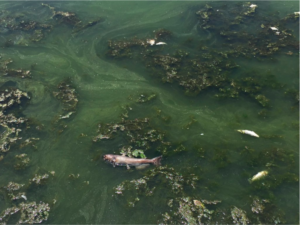
Download this in PDF form, here.
What is a fish kill?
When a lot of fish die in a localized area, it is often referred to as a fish kill or die-off. You will often see dead fish and other aquatic organisms floating on the water’s surface when there is a fish kill. The water around the fish may be scummy, discolored, smell foul, or otherwise appear contaminated (see concerns about Algal Blooms and Discolored and/or Foul-Smelling Water).
What causes a fish kill?
There are many reasons why you may see a fish kill (see the Missouri Department of Conservation page on fish kills), but the most common cause is low oxygen concentration in water. Nutrient pollution from CAFOs can produce algal blooms which over-consume oxygen and produce “dead zones” in the water where you may observe these fish kills.
Why should you be worried?
Fish kills are generally indicative of other contamination concerns. Disease and other natural events can lead to a fish kill, but according to the Missouri Department of Conservation, “municipal and agricultural waste water have been the leading sources of fish kills in Missouri since the 1940s” (MDC). Therefore, if you see a fish kill it may be evidence of pollution concerns and a warning sign to test your water.
What can you do?
- Call the Missouri Department of Natural Resources Environmental Emergency Response (EER) Section at 573-634-2436. The DNR considers fish kills an environmental emergency: an event which “poses an immediate threat to the public health or the well-being of the environment”. Therefore, you should report fish kills to this 24-hour hotline number. See Reporting Concerns.
- Report a fish kill to the Missouri Department of Conservation (MDC) here. MDC relies on citizen reporting to monitor fish kills and other water quality concerns, so they want to hear from you. MDC has a spreadsheet of 2019 fish kills in public Missouri waters and their causes which is available on the webpage linked above.
- Take pictures. Photos provide clear evidence of the environmental concern as you witnessed it and can help confirm its location. In the case of a fish kill, a well-taken photo will show the approximate number of fish involved in the kill, characteristics of the surrounding water like color, presence of algae and/or possible pollutants, and perhaps capture some of the surrounding area to identify the location. Unfortunately, neither the MDC fish kill reporting form nor the DNR Environmental Concern Report provides a section to upload images. However, you may email photos to the respective department along with your concern report to provide supporting evidence. Photos are also a good way to demonstrate evidence of harm, which helps establish legal standing for an individual or organization to pursue environmental litigation.
- Test the water. You can collect your own water samples and purchase test strips to perform low-cost water analysis for nitrates, phosphorus and a variety of other water quality criteria. You may compare your results against Missouri’s Water Quality Standards, however note that human and environmental health concerns may still exist at levels below the standard. To perform higher-accuracy tests, you may consider sending water samples to a DNR-certified lab for chemical or microbiological analysis. Some labs are only approved to perform certain water tests, so make sure to choose a lab that can test for the criteria you are interested in (nitrate, phosphorus, E. coli) and use the contact information provided to get a time frame and cost estimate for testing.
The Missouri Stream Team Volunteer Water Quality Monitoring Program (VWQPM) is a partnership of the Department of Natural Resources, Department of Conservation, Conservation Federation of Missouri and citizens of Missouri. VWQPM conducts advanced monitoring projects, which have included nitrate measurements for streams, however VWQPM is not set up to receive and test samples from the public.
The Missouri Department of Health & Senior Services (MDHSS) tests public drinking water supplies for E. coli and coliform bacteria every month (see here). You may also submit your own water samples to the Missouri State Public Health Laboratory (MSPHL) at any time. Use this form from the MSPHL to request a water sampling kit or call MSPHL at 573-751-4830 and contact your local public health agency to find the appropriate sample drop-off location. Note that MSPHL only performs tests for total coliforms and E. coli in drinking water sources; not all water bodies are public drinking water sources and you may want to test your samples for other criteria like nitrates and phosphorus.
